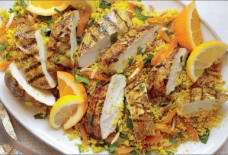The Art of Arabic Calligraphy
The Arabic language is very ancient, but it was not a written language until perhaps the third or fourth century. The Arabic language and its 28 letters, written from right to left, spread with the spread of Islam. The letters are derived from only 17 distinct forms, distinguished from one another by a dot or dots placed above or below the letter. Short vowels are indicated by small diagonal strokes above or below letters.
The early Arabs’ culture was prolific in terms of writing and poetry; they acknowledged the power and beauty of words. Poetry, for example, was an essential part of daily life. The early Arabs felt an immense appreciation for the spoken word and its written form.
Styles of Arabic
Calligraphy
Arabic calligraphy is undoubtedly one of the highest achievements of Islamic art, and over the centuries an enormous number of calligraphic styles have emerged from different regions of the Islamic and Arab world.
Kufi Script
The first formal calligraphic style is called the Kufi style, named after the city of Kufah in Iraq. It was used in many early Qur’an manuscripts and for inscriptions, including those at the Dome of the Rock.
It had a combination of square and angular lines on one hand, and compact bold circular forms on the other hand. The vertical strokes were short, while the horizontal strokes were long and extended. In the second half of the eighth century, the Kufi style became the predominant script used for copying the Holy Qur’an for the next 300 years.
The Kufi styles had more or less vanished by the 13th century; they were replaced by the range of more rounded styles in use at present.
Diwani Script
The Diwani script, which was developed in the late 15th century is a cursive script based on the Ta‘liq style, written on a less dramatically hanging baseline, though its letter connections are vertical and slanted. It is characterized by dramatically curved non-dotted letters, which are joined together in an unconventional fashion, and by ending swashes that often extend below the baseline of letters.
Diwani is written without vocalization marks. It was practiced primarily in the diwan or council where it was used for all of official correspondence.
Thuluth Script
The Thuluth script was first formulated in the seventh century during the Umayyad caliphate, but it did not develop fully until the late ninth century. Though rarely used for writing Qur’an, Thuluth has enjoyed enormous popularity as an ornamental script for calligraphic inscriptions and the titles, headings, and colophons in books. It is still the most important of all the ornamental scripts. Curved letters written with barbed heads characterize Thuluth script. The letters are linked and sometimes intersect. Thuluth is known for its elaborate graphics and remarkable plasticity.
Riq’a Script
The Riq’a script evolved from Naskh and Thuluth. Although Riq’a has a close affinity with Thuluth, Riq’a developed in a different direction. Riq’a became simplified. The geometric forms of the letters are similar to those of Thuluth but are smaller with more curves.
Riq’a is rounded and densely structured with short horizontal stems, and the letter alif is never written with barbed heads.
Riq’a was one of the favorite scripts of Ottoman calligraphers and underwent many improvements. Riq’a went on to become the most popular and widely used script. Today, Riq’a is the preferred script for handwriting throughout the Arab world.
Naskh Script
The Naskh script was one of the earliest scripts to evolve. It gained popularity as it displayed a very rhythmic line. Naskh was reformed into an elegant script worthy of the Qur’an and many writings of Qur’an have been written in Naskh script. Since the script is relatively easy to read and write, Naskh appealed particularly to the general population.
Naskh is usually written with short horizontal stems and with almost equal vertical depth above and below the medial line. The curves are full and deep, the uprights straight and vertical, and the words generally well spaced.
Calligraphy on
Kiswa of Kaaba
Throughout Islamic history, it has been considered a great honor to be able to perform a service to the Kaaba. One of these services is to be able to contribute in the sewing of the Kiswa.
The Kiswa is made of pure natural silk dyed in black. The belt is embroidered with protruding designs that are enameled with silver threads covered with gold. Some Qur’an verses are written on it in Thuluth script.
Under the belt, at each corner of the Kaaba, Surah of Ikhlas is written inside a circle surrounded by a square shape of Islamic embellishment. At the same height, also under the belt, there are six verses of the Holy Qur’an. Each of these verses is written in a separate frame. All that is written under the belt is in Thuluth script of handwriting, embroidered in protruding designs and interwoven with silver threads covered with gold. Each separate side of the Kaaba has certain Qur’an verses written on it.
Decorating Calligraphy
As well as being written with great elegance, there were many ways in which calligraphy could be enhanced by adding decoration. The words themselves could be written in gold, or in colors other than black. Letters and words could also be outlined or lie against a background pattern. In addition, calligraphers combined different sizes, colors, and styles of text for different phrases or sections of text. The decorated frames and background patterns do not interfere with the clarity of the script, or distract from the content of the text. Designs with calligraphy were created out of many different materials, yet calligraphy often imitates the technical effects of pen on paper, even when it appears on other media.
Samer Yahya
Saudi Gazette


